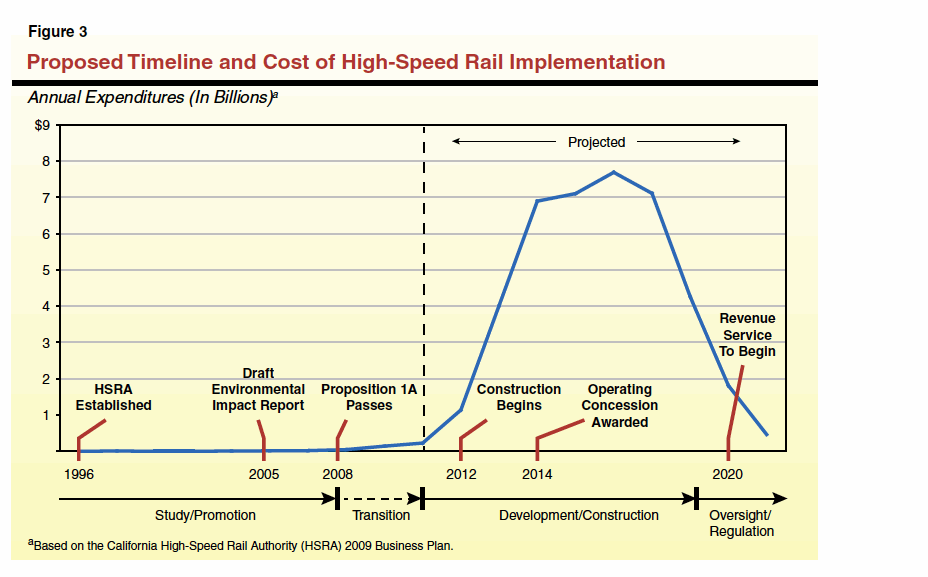LEGISLATIVE ANALYST’S OFFICE
Executive Summary
California’s proposed high–speed rail project would link the state’s major population centers, including Sacramento, the San Francisco Bay Area, the Central Valley, Los Angeles, the Inland Empire, Orange County, and San Diego. The most recent cost estimate for completion of the first phase of the project is roughly $43 billion. In November 2008, voters approved Proposition 1A, which allows the state to sell $9 billion in general obligation bonds to partially fund the development and construction of the high–speed rail system. In addition, the state has received roughly $3 billion from the federal government for its construction. The California High–Speed Rail Authority (HSRA) recently approved plans to begin construction in fall 2012 on a portion of the system costing roughly $5.5 billion through the Central Valley that spans from north of Fresno to north of Bakersfield. The Legislature will likely be asked to appropriate much of the funding for this initial segment in 2012–13.
A Number of Problems Threaten Successful Development of High–Speed Rail. In this report, we describe a number of problems that pose threats to the high–speed rail project’s successful development as envisioned by Proposition 1A. For example, the availability of the additional funding assumed in a 2009 business plan as necessary to complete the project is highly uncertain and federal deadlines and conditions attached to the funding already provided to the state would limit the state’s options for the successful development of the system. In addition, the existing governance structure for the project is inadequate for the imminent development and construction stages and the Legislature lacks the good information it needs to make critical multi–billion dollar decisions about the project that it will soon face.
Legislative Actions Could Improve Likelihood of Project’s Success. The Legislature faces some challenging choices about whether to continue with a project that, despite the problems outlined above, could have some reductions in other spending for transportation improvements as well as air quality and other environmental benefits. If the Legislature chooses to go forward with the high–speed rail project, we have concluded that two key steps could be taken now to improve the likelihood of its successful development. First, the Legislature needs more time and greater flexibility to make critical decisions relating to the project. This would require modifications to the federal restrictions that have been imposed on the project regarding the timing of the expenditure of these federal funds, as well as to a federal administrative decision to require that they all be spent building an initial section of the rail line in the Central Valley. Second, significant improvements are needed in the way both day–to–day and longer–term strategic decisions are made. We have concluded that the current governance structure for the project is no longer appropriate and is too weak to ensure that this mega–project is coordinated and managed effectively.
Download full version (PDF): High-Speed Rail Is at a Critical Juncture
About the Legislative Analyst’s Office
www.lao.ca.gov
“The Legislative Analyst’s Office has been providing fiscal and policy advice to the Legislature for more than 70 years. It is known for its fiscal and programmatic expertise and nonpartisan analyses of the state budget. The office serves as the “eyes and ears” for the Legislature to ensure that the executive branch is implementing legislative policy in a cost efficient and effective manner.”
Tags: CA, California, Eric Thronson, Farra Bracht, HSR, LAO, Legislative Analyst's Office







 RSS Feed
RSS Feed